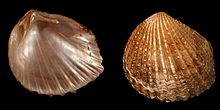Neotrigonia margaritacea
| Neotrigonia margaritacea | |
|---|---|

| |
| A whole shell of Neotrigonia margaritacea with the valves separated. The right valve is on the left. | |
| Scientific classification | |
| Domain: | Eukaryota |
| Kingdom: | Animalia |
| Phylum: | Mollusca |
| Class: | Bivalvia |
| Order: | Trigoniida |
| Family: | Trigoniidae |
| Genus: | Neotrigonia |
| Species: | N. margaritacea
|
| Binomial name | |
| Neotrigonia margaritacea | |
| Synonyms[1] | |
| |
Neotrigonia margaritacea, common name the pearly brooch-shell, is a species of saltwater clam, a marine bivalve mollusc in the family Trigoniidae. This species is known from sandy substrates in shallow seas in southeastern and southwestern Australia. This species was the first member of the family to be discovered alive; previous to its discovery, trigoniids were only known from fossils.
History
Jean-Baptiste Lamarck first described Neotrigonia margaritacea (under the name Trigonia margaritacea) in 1804. It was what is now known as a "living fossil", being the first known living member of the Trigoniidae, a family of bivalve mollusks that was well known from fossils, but that had been thought to have become extinct not long after the end of the Mesozoic Era. In 1912, Cossman renamed the genus Neotrigonia, and this genus now contains several other species discovered subsequently, all from the waters around Australia and Tasmania.[2]
Description

The shell of Neotrigonia margaritacea is thick and heavy for its size. The typical width of the adult shell is 40 mm (1.6 in). In the living animal, the interior of the valves is nacreous and tinged pink. This colour can eventually be lost in empty shells, though a metallic lustre does persist.[3]
This clam is capable of opening its shell quite widely; the valves are kept properly aligned and articulated by a series of massive and smaller teeth on the hinge line. The animal does not have siphons. It respires using filibranch gills. The foot is basically L-shaped, large and muscular, with an additional heel-like lobe.[2]
Ecology
Neotrigonia margaritacea is a suspension feeder which lives in sand. It is able to move about[4] and can use its foot to jump.[2]
References
- ^ a b Rosenberg, G.; Huber, M. (2014). "Neotrigonia margaritacea (Lamarck, 1804)". WoRMS. World Register of Marine Species. Retrieved 2014-04-25.
- ^ a b c Stanley, Steven M. (1984). "Neotrigonia, the Sole Surviving Genus of the Trigoniidae (Bivalvia, Mollusca)". Living Fossils: Casebooks in Earth Sciences: Neotrigonia, the Sole Surviving Genus of the Trigoniidae (Bivalvia, Mollusca). Casebooks in Earth Sciences. Springer. pp. 243–246. doi:10.1007/978-1-4613-8271-3_30. ISBN 978-1-4613-8271-3.
- ^ Grove, S. J. (2014-04-18). "Trigoniidae: Neotrigonia margaritacea (Lamarck, 1804) ('pearly brooch-shell')". A Guide to the Seashells and other Marine Molluscs of Tasmania. Retrieved 2014-04-25.
- ^ "Neotrigonia margaritacea Lamarck 1804 (clam)". Paleobiology database. Fossilworks. Retrieved 2014-04-26.
